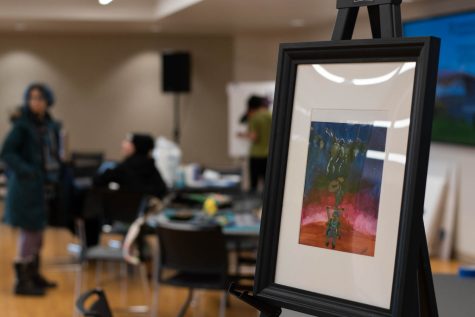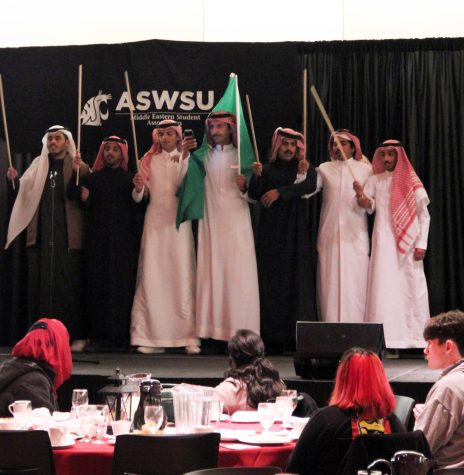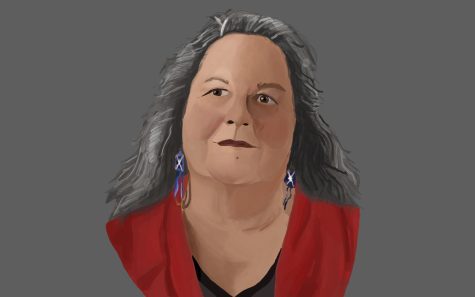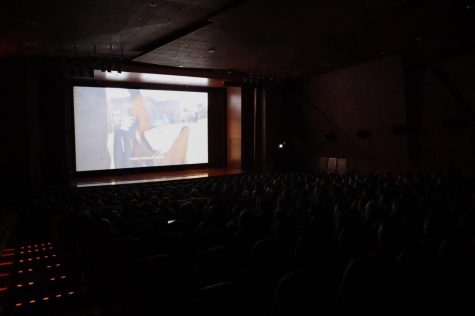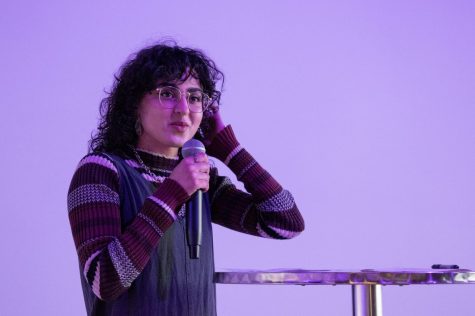A new and different tune
April 3, 2017
{{tncms-asset app=”editorial” id=”bb27601c-182c-11e7-a2c4-9fd305d8c277″}}
Two composition students won the two Crimson Awards, the highest-level award Showcase for Undergraduate Research and Creative Activities (SURCA) gives, for the Arts and Design Category.
Junior Jake Kargl presented his original work “Tempting Time” and recorded each part individually, layering the tracks and showing a video of him performing all the parts. Senior Kirill Polyanskiy was recognized for his research into violin subharmonics, along with co-authors Makiah Heinzmann and Keadrin Dick.
“Tempting Time” premiered last semester at the percussion concert in October. Kargl began working on it in the summer of 2016, with the specific goal of making it hard for the audience to predict where the music would go.
The seven-part, seven-minute piece drew inspiration from progressive rock music and the feeling of always being on a deadline, Kargl said.
“ ‘Tempting Time’ refers to the rhythmic complexity as well as my personal feeling of … always having a clock in my head,” Kargl said. “It’s a testament to my feeling of inconsistent time flow.”
Both Polyanskiy and Kargl credit composition teacher Scott Blasco for pushing them to present their respective projects.
“[Blasco] noticed how much I have been writing, and he thinks that I’m doing pretty advanced stuff for being so early in the program,” Kargl said. “The complexity of the piece made it something he thought would be cool to share with the rest of campus.”
It took about 13 hours to record all seven different parts, then about nine hours to mix the tracks together. Kargl enlisted the help of friend Andrew Swanson to shoot and edit the accompanying video.
“Besides being a composer and an audio engineer, I’m also a performer,” Kargl said. “It’s just a personal thing for me that I wanted to record everything myself, especially for my first percussion piece.”
Polyanskiy has messed around with violin subharmonics ever since a friend, Heinzmann, suggested he consider them. Using subharmonics, or subtones, enables a player to play notes lower than the lowest note on the violin.
Polyanskiy built upon the already-established research by Mari Kimura, a Japanese violinist, who is known for her work on violin subharmonics. Polyanskiy documented exactly how to produce the violin subtones, and came up with musical notation so composers can use these subtones in pieces. Heinzmann improved upon the musical notation and made it much clearer to read.
“Dr. Blasco told me to write up my research and pointed out that I can get money for this,” Polyanskiy said. “I was just doing this on the side, but Makiah and Keadrin really pushed me to do this.”
Heinzmann worked on the graphics, took pictures and improved upon the musical notation Polyanskiy had come up with while Dick helped to demonstrate subtones at SURCA and edited the writing Polyanskiy had done.
“He got all of his research, all of his information, on paper,” Dick said. “We made it look pretty and into a presentable poster.”
Polyanskiy’s research helped Dick, who is a cello player, start to produce subtones herself.
“I was able to consistently get the major 7th interval, and play melodies a major 7th down,” Dick said.
At SURCA, Polyanskiy and Dick performed a duet featuring violin subharmonics that Polyanskiy had composed for the Festival of Contemporary Art Music, which featured original works by several student composers at WSU.
“The most important thing that comes out of this is the notation, and the technique,” Polyanskiy said. “You get the ability to play, and the ability for composers to write for you to play.”
Polyanskiy plans to write etudes, teaching pieces, to teach other violinists how to achieve subtones. In his research, he wrote that the most important factors when attempting subharmonics included bow pressure, bow placement, bow speed, bow tilt, strings and rosin.
“I find it exciting so many people liked our presentation,” Dick said. “We got an overall positive response from people who didn’t even know how violin works.”
Both projects demonstrated the power of original composition and the value of pushing music’s limits in a day and age where it can sometimes seem like contemporary music is being devalued.
One project highlighted Kargl’s talent in multiple levels – as a performer and an audio engineer. The other project pushed the boundaries of music itself and expanded upon the capabilities of stringed instruments.












